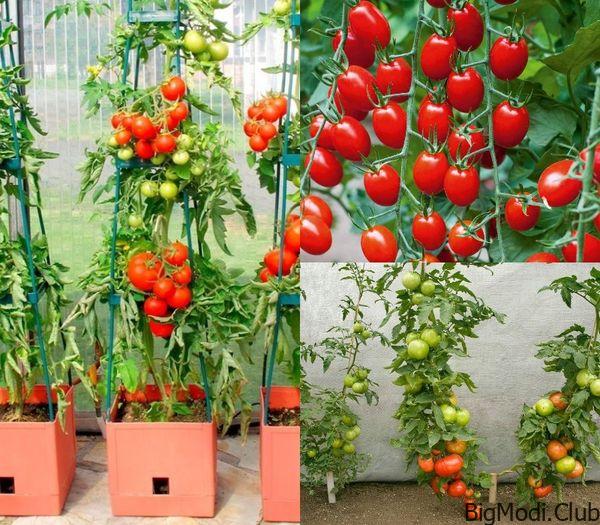Diving deeper into advanced tomato growing methods allows you to refine your gardening techniques, optimize yields, and enhance the quality of your tomatoes. Below, I’ll elaborate on each method, providing you with more detailed insights and tips.
1. Grafting Tomatoes
Grafting is an advanced technique where two tomato plants are joined to form one superior plant. The rootstock, chosen for its vigor and disease resistance, is paired with a scion that produces desirable fruit.
- Why Graft? Grafting can increase resistance to soil-borne diseases like verticillium wilt and nematodes. It also enables plants to thrive in less-than-ideal soil conditions.
- How to Graft: The process involves making a clean cut at the seedling stage, then securing the scion and rootstock together with a grafting clip. The grafted plants are then kept in a high-humidity environment to heal before being transplanted.
- Challenges: Grafting requires precision and practice. If done improperly, the graft may fail, leading to plant loss.
2. Vertical Growing
Training tomatoes to grow vertically maximizes space and improves plant health.
- Types of Vertical Structures:
- Trellises: A trellis can support multiple plants, allowing them to spread vertically. Ensure the trellis is sturdy enough to handle the weight of the plants.
- String Training: Used in greenhouses, a string is attached to the ceiling and tied to the base of the plant. The plant is wound around the string as it grows, promoting a single, tall stem.
- Cages: Heavy-duty tomato cages support the plant from all sides, preventing branches from sagging under the weight of the fruit.
- Benefits: Vertical growing improves air circulation, reduces the risk of fungal diseases, and makes it easier to manage and harvest the plants.
3. Hydroponic Systems
Hydroponics is a soil-less growing method that provides plants with a nutrient solution directly.
- Types of Hydroponic Systems:
- Nutrient Film Technique (NFT): A thin film of nutrient solution flows over the plant roots, providing constant nourishment.
- Deep Water Culture (DWC): Plant roots are suspended in a nutrient-rich water solution, with air stones providing oxygen.
- Drip Systems: Nutrients are delivered directly to the root zone via drip emitters, ideal for larger operations.
- Advantages: Hydroponics allows for precise control over nutrient levels, leading to faster growth and higher yields. It also reduces water usage and eliminates soil-borne diseases.
- Considerations: Hydroponics requires careful monitoring of pH and nutrient concentrations. Equipment like pumps, reservoirs, and grow lights can add to the initial cost.
4. Pruning for Maximum Yield
Pruning is critical for controlling tomato plant growth and improving fruit production.
- Techniques:
- Removing Suckers: These are the shoots that emerge between the main stem and branches. Removing them directs energy to fruit-bearing branches.
- Topping the Plant: Once the plant reaches a desired height, the top can be pruned to focus energy on fruit production rather than further vertical growth.
- Thinning Foliage: Removing excess leaves increases light penetration and air circulation, reducing the risk of disease.
- Timing: Prune early in the morning when plants are well-hydrated. Regular maintenance throughout the growing season ensures consistent results.
5. Optimizing Light Exposure
Tomatoes thrive in full sunlight, but optimizing light exposure can enhance growth and yield.
- Outdoor Growing: Position plants in a south-facing location to maximize sunlight. If natural light is insufficient, consider using reflective surfaces to increase light exposure.
- Indoor/Greenhouse Growing: LED grow lights can supplement natural light, providing the necessary spectrum for photosynthesis. Adjust the light intensity and duration based on the growth stage of the plant.
- Tips: Ensure even light distribution to prevent uneven growth. Regularly rotate pots or trays if using grow lights.
6. Companion Planting
Companion planting leverages the benefits of certain plants to support tomato growth.
- Best Companions:
- Basil: Enhances tomato flavor and repels aphids, whiteflies, and other pests.
- Marigolds: Known to deter nematodes and other harmful insects.
- Garlic and Onions: Help repel spider mites and other pests, while also improving soil health.
- Strategic Planting: Position companion plants close to tomatoes but not too close to avoid competition for nutrients. Companion plants should be in the same sun exposure zone as tomatoes.
7. Soil Health Management
Healthy soil is the foundation for robust tomato plants.
- Soil Amendments: Regularly incorporate organic matter such as compost, worm castings, or aged manure to improve soil structure and nutrient content.
- Compost: Enhances water retention and provides a slow-release source of nutrients.
- Worm Castings: Rich in beneficial microbes that promote healthy root development.
- Crop Rotation: Avoid planting tomatoes in the same spot each year. Rotate with crops like beans, peas, or cover crops like clover to restore nitrogen levels in the soil.
- Soil Testing: Conduct regular soil tests to monitor pH and nutrient levels. Tomatoes prefer slightly acidic soil with a pH between 6.0 and 6.8.
8. Using High Tunnels or Greenhouses
Growing tomatoes in high tunnels or greenhouses extends the growing season and protects plants from adverse conditions.
- Benefits: These structures create a controlled environment, reducing the impact of weather fluctuations and extending the growing season. They also protect plants from pests and diseases.
- Climate Control: Use ventilation systems, fans, and shade cloths to manage temperature and humidity. Automated systems can monitor and adjust these factors for optimal plant growth.
- Considerations: High tunnels are more affordable but offer less control compared to greenhouses. Greenhouses allow for year-round growing but require a significant initial investment.
9. Advanced Fertilization Techniques
Proper fertilization is key to maximizing tomato growth and yield.
- Slow-Release Fertilizers: Provide a steady supply of nutrients over time, reducing the need for frequent applications. Ideal for both in-ground and container-grown tomatoes.
- Organic Amendments:
- Fish Emulsion: High in nitrogen, promoting vigorous growth during the early stages.
- Bone Meal: Rich in phosphorus, essential for root development and fruiting.
- Kelp Extract: Contains trace minerals and growth hormones that enhance overall plant health.
- Foliar Feeding: Applying nutrients directly to the leaves allows for faster absorption, particularly when plants are stressed or showing nutrient deficiencies.
10. Pest and Disease Management
A proactive approach to pest and disease management ensures healthier plants and better yields.
- Integrated Pest Management (IPM): Combines cultural, biological, and chemical methods to control pests and diseases.
- Cultural Controls: Crop rotation, sanitation, and selecting disease-resistant varieties.
- Biological Controls: Introduce beneficial insects like ladybugs, predatory mites, or parasitic wasps to control pests naturally.
- Organic Pesticides: Use neem oil, insecticidal soap, or Bacillus thuringiensis (Bt) to manage pest populations. Always follow label instructions for safe application.
- Disease Prevention: Regularly inspect plants for early signs of disease. Remove and dispose of infected plant material to prevent spread. Use disease-resistant varieties and practice crop rotation to reduce disease pressure.
You can significantly improve the health, yield, and quality of your tomato plants. Whether you’re a hobbyist looking to take your garden to the next level or a commercial grower aiming for peak production, these methods offer the precision and control needed for success.
FAQs:
What is the Best Practice for Growing Tomatoes?
The best practice for growing tomatoes involves a combination of proper planting, soil management, watering, and pest control:
- Location: Choose a sunny spot where the plants will receive at least 6-8 hours of direct sunlight each day.
- Soil Preparation: Use well-draining, fertile soil enriched with organic matter like compost. The soil should have a slightly acidic to neutral pH (6.0-6.8).
- Watering: Water deeply and consistently, aiming to keep the soil evenly moist but not waterlogged. Water at the base of the plant to avoid wetting the foliage, which can lead to disease.
- Staking/Support: Provide support with cages, stakes, or trellises to keep the plants upright and prevent fruit from touching the ground.
- Pruning: Regularly prune suckers (small shoots between the main stem and branches) to encourage better air circulation and direct the plant’s energy to fruit production.
- Fertilization: Use a balanced fertilizer or compost tea throughout the growing season, adjusting based on the plant’s needs.
- Pest and Disease Management: Implement integrated pest management (IPM) practices, including crop rotation, companion planting, and the use of organic pesticides if necessary.
How to Speed Up Tomato Growth?
To speed up tomato growth, consider the following techniques:
- Start Indoors: Begin seeds indoors 6-8 weeks before the last expected frost. This gives you a head start on the growing season.
- Use a Greenhouse or High Tunnel: Growing tomatoes in a controlled environment can accelerate growth by providing consistent warmth and protection from the elements.
- Warm the Soil: Use black plastic mulch or row covers to warm the soil before planting, as tomatoes thrive in warm soil.
- Use a Balanced Fertilizer: Apply a fertilizer with a slightly higher phosphorus content to encourage root development and early fruiting.
- Water Consistently: Inconsistent watering can stress the plants and slow growth. Keep the soil evenly moist.
- Prune Lower Leaves: Remove the lower leaves that are close to the ground to improve air circulation and reduce disease risk, which can otherwise hinder growth.
- Optimize Light Exposure: Ensure plants receive maximum sunlight. For indoor growing, use full-spectrum LED grow lights to supplement natural light.
What is the Most Profitable Tomato to Grow?
The most profitable tomato to grow often depends on your market and growing conditions, but here are some commonly profitable varieties:
- Heirloom Varieties: Heirloom tomatoes like ‘Brandywine,’ ‘Cherokee Purple,’ and ‘Black Krim’ are highly sought after for their unique flavors and appearance, commanding higher prices at farmers’ markets and specialty stores.
- Cherry Tomatoes: Varieties like ‘Sungold’ and ‘Sweet 100’ are popular due to their high yield and consistent demand. They are particularly profitable in local markets and CSA (Community Supported Agriculture) shares.
- Beefsteak Tomatoes: These large, meaty tomatoes are a favorite for slicing and sandwiches, making them popular in both home gardens and commercial markets.
- Organic Tomatoes: Growing any variety organically can increase profitability, as organic tomatoes typically sell for a premium.
What is the Method of Growing Tomatoes?
The method of growing tomatoes can vary based on the scale and environment, but here’s a general guide:
- Starting Seeds:
- Begin indoors 6-8 weeks before the last frost date.
- Use seed trays with a light, sterile starting mix. Keep the soil moist and warm (70-75°F) for optimal germination.
- Transplant seedlings to larger pots once they have two sets of true leaves.
- Transplanting Outdoors:
- Harden off seedlings by gradually exposing them to outdoor conditions over a week.
- Plant in a location with full sun, spacing plants 18-24 inches apart for determinate varieties and 24-36 inches apart for indeterminate varieties.
- Bury the plants deeper than they were in the pots, up to the first set of true leaves, to encourage strong root growth.
- Support and Maintenance:
- Provide support using cages, stakes, or trellises.
- Mulch around the base of the plants to retain moisture and suppress weeds.
- Water regularly and deeply, aiming to keep the soil consistently moist but not soggy.
- Fertilization:
- Apply a balanced fertilizer or compost when planting and continue feeding every 4-6 weeks.
- Consider side-dressing with compost or a tomato-specific fertilizer mid-season to boost growth.
- Pruning and Training:
- Prune suckers to improve airflow and direct energy towards fruit production.
- For indeterminate varieties, consider removing the growing tip after the plant has set a desirable amount of fruit to encourage ripening.
- Pest and Disease Management:
- Regularly inspect plants for signs of pests or disease.
- Use organic or chemical treatments as necessary, and practice crop rotation to prevent soil-borne diseases.
- Harvesting:
- Harvest tomatoes when they are fully colored and slightly soft to the touch. For best flavor, pick them at their peak ripeness.
- Continue harvesting regularly to encourage further production.


